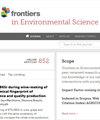Spatial and temporal changes and influencing factors of urban ecological efficiency in the Yellow River Basin
IF 3.3
3区 环境科学与生态学
Q2 ENVIRONMENTAL SCIENCES
引用次数: 0
Abstract
The Yellow River Basin serves as a vital ecological shield for China, and enhancing the urban ecological efficiency (UEE) is essential for the region’s ecological civilization and high-quality development. This research employs the slacks-based measure-data envelopment analysis (SBM-DEA), which incorporates undesirable outputs, and the Malmquist index to measure the UEE of 65 cities in the Yellow River basin from 2008 to 2017, described its spatio-temporal evolution characteristics, and utilizes its influencing factors using the Bootstrap truncated regression model. The main findings are as follows. ① The UEE in the Yellow River Basin has seen a steady, albeit low, increase from 2008 to 2017, with notable disparities existed in the upper, middle and lower reaches. Low pure technical efficiency is the main factor limiting the improvement of UEE in the Yellow River Basin. ② Cities with higher ecological efficiency in the Yellow River Basin generally exhibit a spatial distribution pattern of “lower reaches > middle reaches > upper reaches,” and it shows that cities with growing UEE are continuously shifting to the middle and lower reaches. ③ Environmental regulation, scientific and educational investment, economic scale, and greening level significantly promote the improvement of UEE in the Yellow River Basin, but population density and industrial structure lead to a decline in UEE. However, this result is heterogeneous between the upper, middle, and lower reaches, such as environmental regulation hindering the growth of UEE in the upper reaches, scientific and educational investment hindering the improvement of UEE in the downstream areas, and industrial structure significantly enhancing UEE in the midstream areas. These findings offer valuable insights for policymakers aiming to address ecological challenges and promote sustainable development within the Yellow River Basin, highlighting the need for targeted strategies that consider regional differences and the unique characteristics of each reach.黄河流域城市生态效益的时空变化及影响因素
黄河流域是中国重要的生态屏障,提高城市生态效率(UEE)对该地区的生态文明建设和高质量发展至关重要。本研究采用包含不良产出的松弛计量-数据包络分析法(SBM-DEA)和Malmquist指数,测算了黄河流域65个城市2008-2017年的城市生态效率(UEE),描述了其时空演变特征,并利用Bootstrap截断回归模型分析了其影响因素。主要研究结果如下。① 2008~2017 年,黄河流域 UEE 呈稳步增长态势,但增幅较低,上中下游存在明显差异。纯技术效率低是制约黄河流域 UEE 提高的主要因素。黄河流域生态效率较高的城市一般呈现 "下游-中游-上游 "的空间分布格局,表明生态效率不断提高的城市不断向中下游转移。环境监管、科教投入、经济规模和绿化水平显著促进了黄河流域 UEE 的提高,但人口密度和产业结构导致了 UEE 的下降。然而,这一结果在上、中、下游之间存在差异,如上游地区的环境规制阻碍了 UEE 的增长,下游地区的科教投入阻碍了 UEE 的提高,而中游地区的产业结构则显著提高了 UEE。这些发现为旨在应对黄河流域生态挑战和促进可持续发展的政策制定者提供了有价值的见解,强调了考虑地区差异和各河段独特性的针对性战略的必要性。
本文章由计算机程序翻译,如有差异,请以英文原文为准。
求助全文
约1分钟内获得全文
求助全文
来源期刊

Frontiers in Environmental Science
Environmental Science-General Environmental Science
CiteScore
4.50
自引率
8.70%
发文量
2276
审稿时长
12 weeks
期刊介绍:
Our natural world is experiencing a state of rapid change unprecedented in the presence of humans. The changes affect virtually all physical, chemical and biological systems on Earth. The interaction of these systems leads to tipping points, feedbacks and amplification of effects. In virtually all cases, the causes of environmental change can be traced to human activity through either direct interventions as a consequence of pollution, or through global warming from greenhouse case emissions. Well-formulated and internationally-relevant policies to mitigate the change, or adapt to the consequences, that will ensure our ability to thrive in the coming decades are badly needed. Without proper understanding of the processes involved, and deep understanding of the likely impacts of bad decisions or inaction, the security of food, water and energy is a risk. Left unchecked shortages of these basic commodities will lead to migration, global geopolitical tension and conflict. This represents the major challenge of our time. We are the first generation to appreciate the problem and we will be judged in future by our ability to determine and take the action necessary. Appropriate knowledge of the condition of our natural world, appreciation of the changes occurring, and predictions of how the future will develop are requisite to the definition and implementation of solutions.
Frontiers in Environmental Science publishes research at the cutting edge of knowledge of our natural world and its various intersections with society. It bridges between the identification and measurement of change, comprehension of the processes responsible, and the measures needed to reduce their impact. Its aim is to assist the formulation of policies, by offering sound scientific evidence on environmental science, that will lead to a more inhabitable and sustainable world for the generations to come.
 求助内容:
求助内容: 应助结果提醒方式:
应助结果提醒方式:


